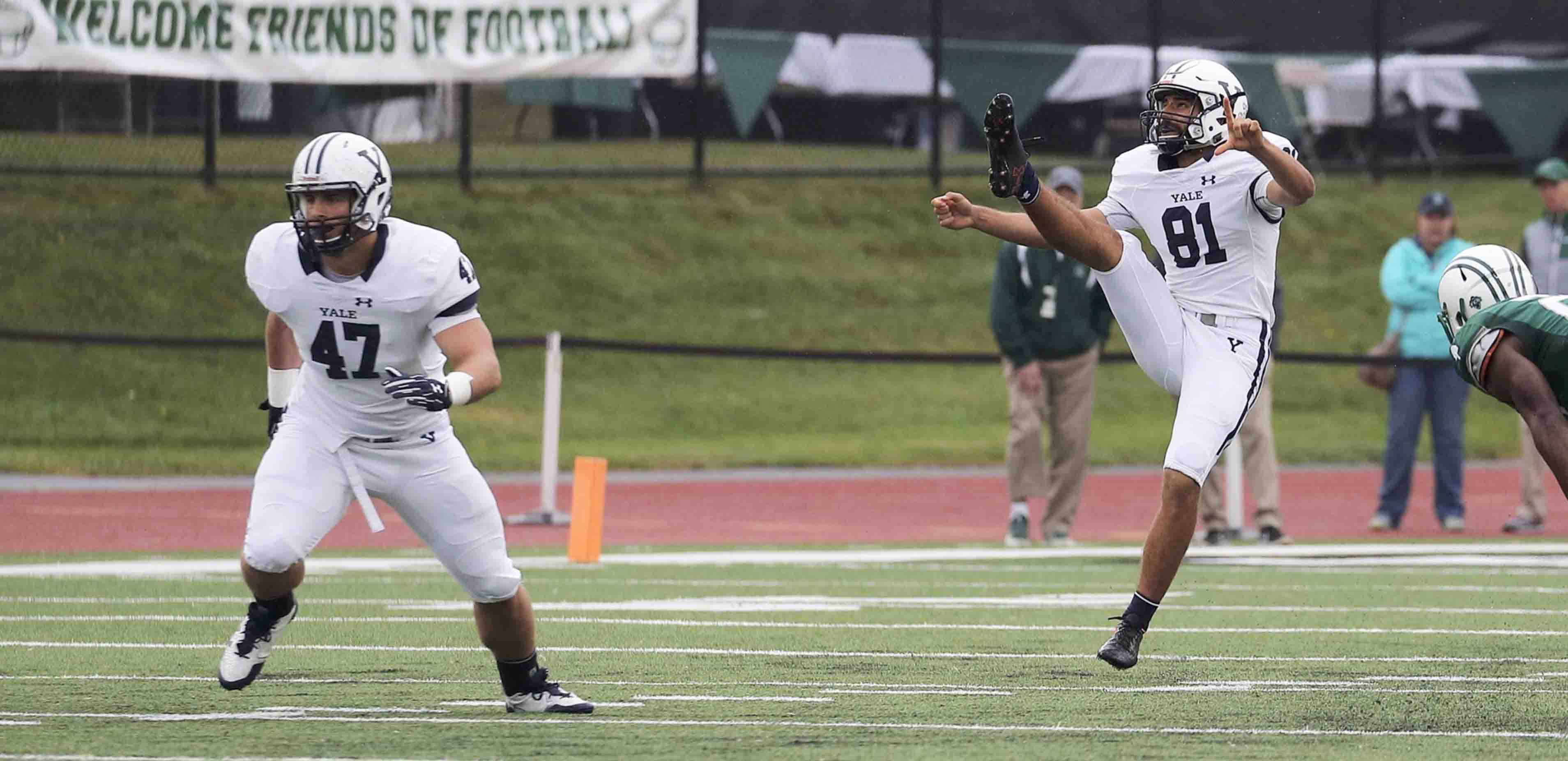
YaleAthletics
Through six games, the Yale football team has garnered national attention for its explosive running attack and dominant defensive front. The Bulldogs rank in the top two in the Football Championship Subdivision in yards per carry, tackles for loss per game and sacks per game.
But in addition to Team 145’s success in those common metrics, the Elis have also shown impressive control of the finer details of the game in areas such as field position. Across 80 offensive possessions this season, Yale’s average starting field position has been more than seven yards better per drive than that of its competition. More impressively, the Bulldogs have started inside their own 20-yard line only 11 times, a stark contrast to the 29 times its opponents have started in the same position.
Field position serves as a strong indicator of success in all three phases, as it requires a defense that can force three-and-outs, an offense that can move the ball away from its side of the field and a special teams unit that can cover long kicks and punts.
“It’s pretty apparent that field position is a huge part of football,” linebacker Matt Oplinger ’18 said. “Being able to pin teams down limits their play selection and gives us a chance to get after them … It takes a whole team to win a football game, especially like that, [and] the special teams are a huge portion of the game.”
Starring for Yale as the primary placekicker and punter, Alex Galland ’19 has led the charge in creating Team 145’s field-position advantage. Galland became the Elis’ top kicker last season, after serving as a backup in 2015, and eventually took over punting duties as well. One year later, the Bakersfield, Calif. native, who is fresh off an Ivy League Honor Roll mention from Week 6, has grown into his role with a knack for flipping the field in the Bulldogs’ favor.
Galland currently ranks third in the Ancient Eight in both yards per punt and net punting, but he separates himself from other punters in his ability to pin teams deep inside their own territory. More than half his 27 punts have been touched down inside the opponent’s 20-yard line, offering the Yale defense ample room to work with time and time again. Galland’s top performance of the season thus far came against Cornell on Sept. 23, when he booted six punts for an average of 43.3 yards. He also placed four kicks inside the 20-yard line and unleashed his season-long punt of 55 yards.
“When I’m doing well, I’m making sure that I’m staying detail-oriented,” Galland said. “When you hit a good ball, a lot of times you’ll say, ‘I hit a good ball, I don’t have to work on that.’ But there are always things you can still work on. Each week, I’m still trying to do better than the previous week. It’s about making sure that you aren’t getting complacent.”
The Bulldogs’ ability to flip the field factored heavily into their 32–0 demolition of Holy Cross two games ago. The Crusaders’ first three drives and final three drives all began with an average starting field position around the 10-yard line. While Galland pinned the opposition inside its own 20 four times with his punting proficiency, precise placement by kicker Sam Tuckerman ’20 prevented Holy Cross from starting possessions with ideal field position after kickoffs.
Beginning in the 2016 season, the Ivy League required its teams to kickoff from the 40-yard line in conference games, as opposed to the traditional 35-yard mark. With the ball moved up five yards, the Bulldogs could simply play for a probable touchback in hopes of their opposition starting a possession from the 20-yard line. However, Tuckerman’s ability to drop his kickoffs around the one-yard line forces teams to field the live ball in the shadow of their own end zone, often resulting in worse field position.
“[Yale] was in our end of the field the whole first quarter, and we just seemed to dig ourselves a hole, and we never could really get out of it,” former Holy Cross head coach Tom Gilmore said after the defeat against Yale that led to his dismissal. “Everytime we did a couple things, we couldn’t string them together. So, it was a good day for Yale and a bad day all the way around for Holy Cross in all three phases of the game.”
But in a one-score game like the Elis’ 24–19 victory over Penn last Saturday, favorable field position proved to be even more advantageous. In all four quarters of the contest, the team with the better average starting field position scored either as many or more points as its opponent in that quarter.
In the Elis’ opening six games, Galland has improved on last season’s punting average by more than four yards. The kicker, who doubles as a trumpet player for the Yale Precision Marching Band prior to the opening kickoff, has already dropped 15 punts inside the 20-yard line and is just three short of his mark from 2016, with four more games still to play.
“Alex has done a great job this season with placement,” Reno said after Yale’s victory over Holy Cross. “It really started at the end of last season, he places the ball really well on punts. That helps us so much with field position. He had a 40-yard average [today]… The last kick, I made him kick it out of bounds so we didn’t have to cover it. That tells you a lot about how he kicked it.”
Galland will go head-to-head with the Ivy League’s leading punter, Columbia’s Parker Thome, when the Lions take on the Bulldogs at the Yale Bowl this Saturday.
Won Jung | won.jung@yale.edu
Joey Kamm | joseph.kamm@yale.edu







